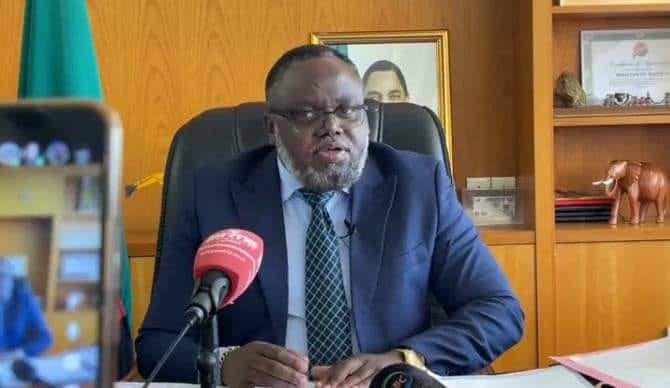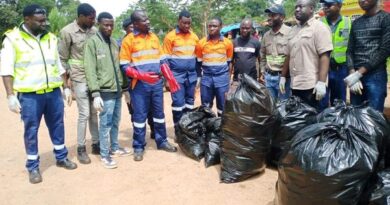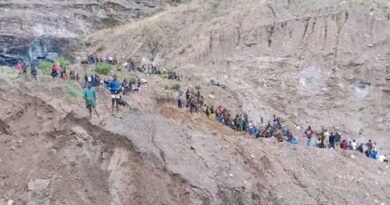Zambia’s Mining Sector Shows Strong Growth in Second Quarter of 2025 – Minister Kabuswe
The Zambian mining sector continues to demonstrate a robust growth trajectory, according to a press briefing held today by Honourable Paul C. Kabuswe, MP, Minister of Mines and Minerals Development. The briefing, which focused on the second-quarter performance of 2025, also highlighted key policy reforms, investment activities, and opportunities for artisanal and small-scale miners (ASMs).
Preliminary statistics show that total copper production reached 439,644.29 metric tonnes in the second quarter, up from 373,263.9 metric tonnes during the same period in 2024 – representing a 17.78% increase. Small-scale miners contributed 39,477.8 metric tonnes, accounting for 9% of total production.
The increase was driven largely by output from Konkola Copper Mines (KCM), Mopani Copper Mines, Kansanshi, and Chibuluma mines. KCM’s production soared to 35,387.91 metric tonnes from just 880.73 metric tonnes in 2024, marking an extraordinary 3,918% increase. Mopani Copper Mines recorded a 60.38% rise, producing 27,406.21 metric tonnes compared to 17,087.92 metric tonnes in the previous year.
Gold production also saw an uptick, rising 35.93% to 1,777.62 kg from 1,364.19 kg in 2024, largely due to increased output at Kansanshi Mine.
Nickel output decreased by 20.66% to 9,570.23 metric tonnes, attributed to reduced ore availability at FQM Trident’s Enterprise Nickel Mine and Albidon Zambia’s Munali Nickel Mine. Emerald production fell by 16.19% to 11,382.77 kg. The minister emphasised that, despite these declines, overall performance across key mineral commodities indicates the positive impact of government policies on the sector.
Minister Kabuswe noted that the Minerals Regulation Commission Act of 2024 and the Geological and Minerals Development Act of 2025 are now in force following a statutory instrument issued on 13 June 2025. The operationalisation of these laws is expected to strengthen governance, regulation, and oversight in the sector.
The government is actively promoting formalisation of ASMs. To date, 1,488 artisanal mining rights have been granted, with 1,176 issued to individuals and 312 to cooperatives. This translates to approximately 4,296 citizens now participating in the ASM sector since the current administration assumed office.
Through Zambia Gold Company Limited (ZamGold), the government has begun buying gold from ASMs in Rufunsa and Mumbwa, acquiring 13.9 kg of gold with an average purity of 84% by the end of June 2025. A newly developed Pit Side Manual will also guide safe mining practices in areas such as Mufumbwe, Kasempa, and Mpika.
Following the launch of the Zambia Integrated Mining Information System (ZIMIS) on 27 February 2025, technical challenges prompted the government to temporarily revert to the Trimble Folio System while improvements are made.
During the quarter, 560 mining licences were issued, a 42.49% increase from the 393 licences granted in the same period in 2024. This includes licences for artisanal, small-scale, and large-scale exploration and mining.
Significant investments were made by key mining companies. Mopani Copper Mines received a USD 1.1 billion recapitalisation from International Resources Holdings (IRH), settled outstanding supplier debts, and expanded its workforce by 21.3% to 13,058 employees. KCM, now fully operational under Vedanta Resources Holdings Ltd, invested USD 124 million in asset improvements in the first half of 2025, with plans to invest an additional USD 206 million by December 2025.
KCM is also focused on strategic projects such as the Konkola Deep Mining Project, aiming to reach an annual copper output of 300,000 tonnes by 2030. Local supplier engagement remains strong, with nearly 2,000 Zambian vendors registered.
Government efforts to de-risk mining investment continue through the Countrywide High-Resolution Aerial Geophysical Survey (CHRAGS), which has now covered 27.6% of Zambia, including key districts in Western and Northwestern provinces.
Minister Kabuswe concluded that the first half of 2025 signals a strong and positive outlook for Zambia’s mining sector, which remains central to driving economic transformation and diversification under the leadership of President Hakainde Hichilema.



